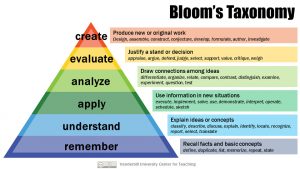In a digital world, information is everywhere, in a mobile phone, a fitness tracker and our brains. Not a science fiction film but the learning theory of connectivism.
The HEFi19 conference looks to the 4th Industrial Revolution and how the development of artificial intelligence and automation continues to take advantage of big data to change not only higher education but also graduate employment. How will artificial intelligence and knowledge residing in machines affect learning?
The idea of connectivism builds on the idea that knowledge resides in humans as well as computers. Placing learners into the knowledge network, they are able to access information from a growing number of nodes in that network.
Before smartphones and widespread internet access, arguments and debates with friends and family over birthday dates or who won the FA Cup 10 years ago could go on for days. Thanks to us all now being nodes in a digital network, we can instantly find out who won every FA Cup since 1872, not to mention the date, the line-up and the attendance.
A key aspect of the learning theory of connectivism is that knowledge doesn’t just live in our brain but also in physical nodes of a network. It feels a little unnerving, but knowledge can reside outside of us, this can be seen in many aspects of everyday life. How reliant are you on a quick internet search or a quick message to someone to ask a question? YouTube contains a huge amount of self-help from DIY fixes to meditation. That connection is broadening with the internet of things and artificial intelligence which takes the connection away from devices with screens to everyday things such as doorbells and fridges – they are learning. The idea of an algorithm replacing a knowledge worker or a robot driving a car is becoming more and more real. We are one of many nodes in the knowledge network.
What does this mean for educators?
Siemens (2005) described connectivism as a learning theory for the digital age. Siemens positions his theory of connectivism alongside traditional learning theories of behaviourism, cognitivism and constructivism.
One thing it does appear to ignore or maybe is not concerned with is how deep the learning is for humans in the network. Does connectivism mean that we simply know where knowledge is and we have the ability to go to the correct node in the knowledge network to retrieve it? Do we ever need to learn anything again and we take a surface (Howie and Bagnall, 2012) level, rather than deep approach to learning? How many times have you been told:
“Just Google it!”
Here, Bloom’s (updated) Taxonomy (Anderson and Krathwohl, 2001) may be able to help. From a connectivist perspective we use all of the nodes in our connected network of knowledge to remember (stage 1 of the taxonomy) – a surface-level approach to learning. Behaviourists, cognitivists and constructivists could all say that they are going much further ‘up’ the taxonomy to have a deeper, richer use of knowledge to:
- Understand
- Apply
- Analyse
- Evaluate
- Create

https://www.flickr.com/photos/vandycft/29428436431 credit Center for Teaching Vanderbilt University
How can we use the enormous amount of connected knowledge both inside and outside of the University to harness deep and higher order learning in the digital world?
How does this affect learning and teaching in a research-intensive university?
Does this approach to learning and teaching help student employability?
Should assessments be open book/device and ask students to use all of their connected information to answer a question or complete a task?
References
Anderson, L. W., & Krathwohl, D. R. (2001). A taxonomy for learning, teaching, and assessing: A revision of Bloom’s taxonomy of educational objectives. New York: Longman.
Siemens, G. (2005) ‘Connectivism: A Learning Theory for the Digital Age’, International Journal of Instructional Technology and Distance Learning’, Volume 2: Number 1. Available at: http://www.itdl.org/Journal/Jan_05/article01.htm
Peter Howie & Richard Bagnall (2012) A critique of the deep and surface approaches to learning model,Teaching in Higher Education, 18:4, 389-400, DOI: 10.1080/13562517.2012.733689
